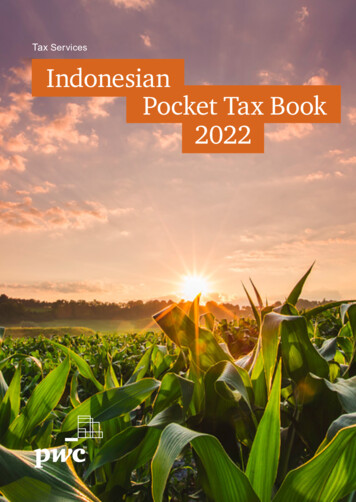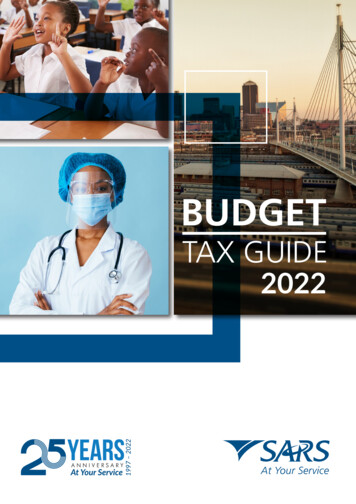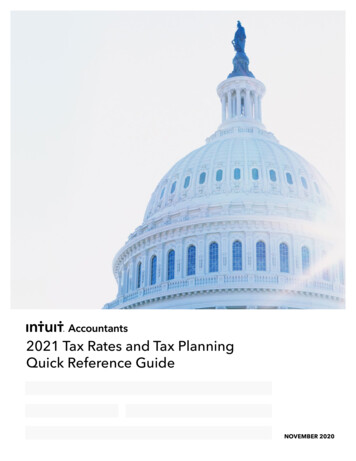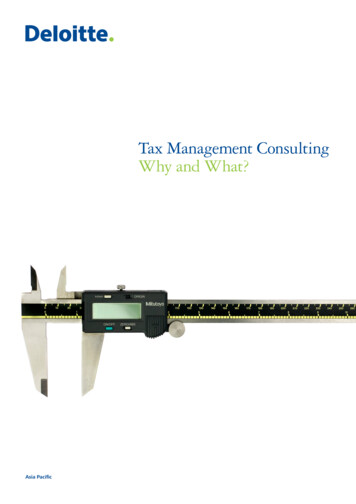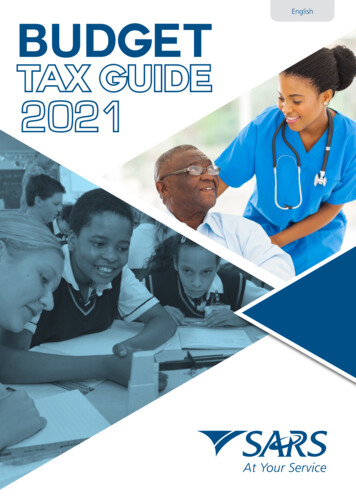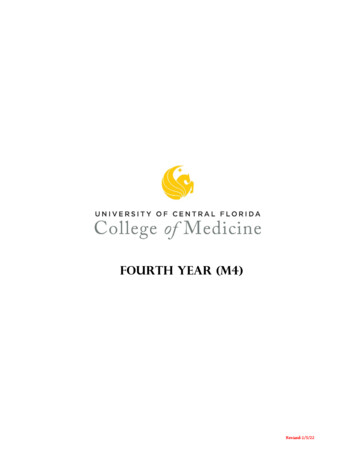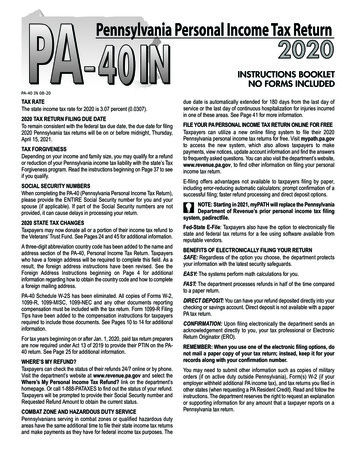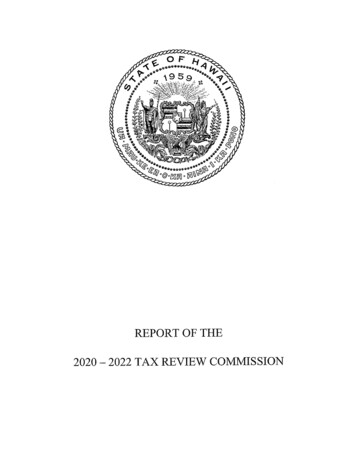
Transcription
THE 2020-2022 TAX REVIEW COMMISSIONElizabeth C. GiestingChairDirector, Hawaiʻi Budget & Policy CenterAlton K. MiyashiroVice ChairTax and Consulting Director, N & K CPAs, Inc.Murray R. ClayPresident, Ulupono InitiativeK. Sayle HirashimaVice President/Controller, Hawaiian Airlines, Inc.Katharine P. LloydSenior Vice President & General CounselHawai‘i Community FoundationScott K. TeruyaDirector of Finance, County of MauiWinston I. WongAssociate Attorney, Chun Kerr LLPCommission StaffDr. Seth S. Colby, Executive Director and Tax Research and Planning OfficerRoderick E. Tuliao, SecretaryJonathan W. White, Writer and Researcher
TABLE OF CONTENTSEXECUTIVE SUMMARY . 1INTRODUCTION . 3The Role and Authorization of the Tax Review Commission . 3Historical Economic Context . 3THE TAX REVIEW COMMISSION’S METHOD AND CRITERIA. 4Framing the Activity of the Tax Review Commission . 4Principles of Sound Tax Policy . 4Progressivity of Hawai‘i's Tax System . 6THE TAX REVIEW COMMISSION’S RECOMMENDATIONS . 91. Impose a Carbon Tax . 92. Commit to an Implementation Study to Impose Environmental Impact Fees . 133. Invest in the Department of Taxation . 154. Create a Committee on Fiscal Responsibility and Sustainable Government Spending . 175. Tax All Retirement Income Equitably . 196. Modernize the Standard Deduction, Personal Exemption, and Income Tax Brackets . 227. Repeal Certain General Excise Tax Exemptions . 258. Increase Transparency of Income Tax Credits . 26CONCLUSION . 27
LIST OF TABLESTable 1: Growth Comparisons Pre- and Post-Pandemic . 4Table 2: Revenue Raised and Retained by State Government . 13Table 3: Annual Cashback per Household . 13Table 4: Forecasted Cost of the Commission’s Recommendation . 23Table 5: Forecast of Alternative Scenarios . 24Table 6: General Fund Revenue Estimates . 27LIST OF CHARTSChart 1: Effective Hawaiʻi State Tax Burden by Income Quintile (Family of 4) . 6Chart 2: Average Effective Income Tax Rates by Income . 7Chart 3: GET Burden by Income and Consumption Quintile . 8Chart 4: Tax-Exempt Pension Benefits by Year . 20LIST OF APPENDIXESAppendix A: “Hawaiʻi Carbon Pricing Study: Additional Scenarios & AdministrativeConsiderations,” Dr. Makena Coffman, Dr. Paul Bernstein, Maja Schjervheim,and Dr. Sumner La CroixAppendix B: “Visitor Green Fee: Report to the Hawaiʻi Tax Commission,” Dr. Jack KittingerAppendix C: “Summary of Recommendations Made by Past Tax Review Commissions,Subsequent Legislation, and Background Information,” Dr. Baybars Karacaovali
EXECUTIVE SUMMARYWe, the members of the 2020-2022 Tax Review Commission convened and completed our workduring the COVID-19 pandemic, a period in which many norms and expectations were disrupted.The State’s visitor-dependent economy came to a months-long stand-still. Hawaiʻi sufferedunprecedented levels of unemployment, and many businesses were permanently shuttered.Although State tax collections dropped dramatically, federal funds provided substantial relief andprevented major government cutbacks. Additional concerns for the future wellbeing of Hawaiʻithat were not directly related to the pandemic included more urgent evidence of the effects ofenvironmental change and global warming, and steeply rising housing costs and inflation that laidbare the stark challenges that low- and middle-income residents face in everyday living. With thissobering backdrop, we considered forward-focused tax issues intended to address Hawaiʻi’schanging conditions and emerging needs, including climate change, meeting future obligations,and increasing tax equity and transparency.Our Recommendations1. Impose a carbon tax to incentivize moving away from carbon-based fuels and adoptingclean energy. We recommend that the majority of the proceeds be rebated as a cashback tothe residents of Hawaiʻi, with a disproportionate distribution to low-income households.2. Develop resources to support a long-term commitment to invest in environmentalrestoration and protection. We recommend that the Legislature fund development of animplementation plan to collect environmental impact fees and put the plan into practicewith all deliberate speed.3. Ensure that taxpayers comply with requirements and pay the taxes they owe. Werecommend that the State maintain and increase as needed its investment in Department ofTaxation staff and systems to enhance compliance.4. Assess and plan for emerging and unfunded government investment needs, and coordinateState and county responsibilities. We recommend the establishment of a Committee onFiscal Responsibility and Sustainable Government Spending to assist with this task.5. Increase tax equity and adequacy by taxing defined benefit pension income to the sameextent that defined contribution retirement income is taxed. We recommend that the first 25,000 in pension income be exempt from taxation for the next 25 years, but fully taxedthereafter. We further recommend that employee contributions to pension plans be taxdeductible.6. Modernize the State’s income tax system and reduce its burden on lower-income taxpayers.We recommend increasing the standard deduction to 3,000 and indexing it to inflation,indexing the personal exemption to inflation, and indexing the individual income taxbrackets to inflation.1
7. Reduce the complexity of the tax system by eliminating outdated and irrelevant generalexcise tax exemptions. We recommend repealing three specific little-used exemptions, andnote that the Auditor’s Office or other analysis may reveal other unused exemptions thatshould be repealed when identified.8. Increase the transparency of Hawaiʻi’s tax system by identifying taxpayers who receivecertain tax credits. We recommend that all income tax credits intended to provide businessincentives require public disclosure of the name of the claimant and amount of the credit.Balancing Tax Adequacy with Purpose, Equity and Progressive ChangeIt was our explicit intention to present our recommendations as an integrated whole that achievesits purposes without sacrificing revenues. For instance, reducing greenhouse gases and imposingenvironmental impact fees should neither reduce revenues nor increase the tax burden for lowerincome taxpayers. Increasing equity in taxing pensions should be mitigated by exempting 25,000in income and making contributions tax deductible. Linking the standard deduction, personalexemption, and tax brackets to inflation enhances the progressivity of our income taxes, butresulting revenue decreases are offset by revenue enhancements from a new carbon tax andimposing income taxes on pensions of more than 25,000.The table below provides revenue estimates of each of our recommendations.General Fund Revenue Estimates ( millions)Recommendation:Impose Carbon Tax w/80% Cashback*Study Environmental Impact FeesAssess and Enhance DOTAX BudgetForm Committee on Long-Term Fiscal SustainabilityLevy Income Tax on Pension Income Over 25,000Index Personal Exemption to InflationIncrease Std Deduction to 3,000 and Index to InflationIndex Individual Income Tax Brackets to InflationEliminate 3 GET ExemptionsIncrease Transparency of Business Tax CreditsTotal AmountYear 1Year 2Year 3Year 4Year 5 Year 887.675.358.9-17.1*Estimate adapted from Carbon Pricing Assessment for Hawai'i: Economic and Greenhouse Gas Impacts (April 2021).2
REPORT OF THE 2020-2022 TAX REVIEW COMMISSIONINTRODUCTIONThe Role and Authorization of the Tax Review CommissionThe Tax Review Commission’s role is clear: evaluate the State’s tax structure and recommendrevenue and tax policy to the Hawai‘i State Legislature. The Tax Review Commission is thendissolved and reconstituted after five years’ time.1 Chapter 232E, Hawai‘i Revised Statutes,provides further guidance and directs the Tax Review Commission to systematically reviewHawai‘i’s tax structure using standards such as equity and efficiency. The Commission is todissolve upon the adjournment of the legislative session to which it submits its recommendations.2Unlike previous Tax Review Commissions, the 2020-2022 Tax Review Commission (theCommission) received no further guidance from the Hawai‘i State Legislature or from theGovernor of Hawai‘i. As such, the Commission had full agency to determine its own agenda andpriorities. However, other limitations arose.Historical Economic ContextFor the second time in the span of a decade, the Tax Review Commission found itself conveningat a time of historic economic insecurity,3 this time brought on by the COVID-19 pandemic.Commencement of the Commission’s work was greatly delayed, not beginning until late into 2020.Furthermore, due to the uncertainty of the State's revenues, the Commission was not appropriateda budget until mid-2021.4 Due to the strain on public finance brought on by the COVID-19pandemic, the Commission faced temptation to focus on short-term responses. However, early inits work the Commission made a firm decision to focus on the future rather than on the immediatecrisis.The effect of the COVID-19 pandemic on Hawai‘i’s revenues was severe. The Department ofTaxation's latest annual report reveals total tax collections decreased by 1.7 percent during fiscalyear 2019-2020.5 This may seem like a small number, but given the Council on Revenues’ forecastof 4.1 percent general fund growth issued just prior to the pandemic,6 it is a drastic decrease. TheCouncil on Revenues general fund forecast for fiscal year 2019-2020 was 7.4 billion. Actualgeneral fund collections for fiscal year 2019-2020 were roughly 6.9 billion.7 500 milliondisappeared in the final few months of fiscal year 2019-2020 alone. Fiscal year 2020-2021 was asimilar story.1HAW. CONST., art. VII, § 3.HAW. REV. STAT. § 232E-2.3TAX REV. COMM'N, REP. OF THE 2010-2013 TAX REV. COMM'N 1-1 (2012).4Historically, Tax Review Commissions receive appropriations and begin work by the summer of the year they areformed. In the case of the current Commission, this would have been the summer of 2020.5HAW. DEP'T OF TAXATION ANN. REP. 2019-2020, at 1 (The 1.7% decrease takes into account the shift of incometax payments into fiscal year 2021 by the due date extension).6COUNCIL ON REVENUES, REP. OF THE COUNCIL ON REVENUES (January 10, 2020) (the Council on Revenues onlyforecasts general fund revenues; the percentage decrease figure earlier cited includes all tax revenues).7HAW. DEP'T OF TAXATION ANN. REP. 2019-2020, at 3.23
The fiscal picture turned around sharply, however. Current collections and the most recent Councilon Revenues forecast show a return to 2019 levels of total collections and a return to steady andpredictable revenue growth.8 Table 1 below shows that the Council on Revenues projects theState's general fund revenue to have fully recovered by fiscal year 2022-2023. If actual revenuesfollow the forecast, by 2023 the general fund will be at the level that it would have been if thepandemic and associated economic disruptions had never happened.Table 1 – Growth Comparisons Pre- and Post-PandemicFY 2020FY 2021FY 2022FY 2023FY 2024FY 2025FY 2026FY 20-26 7,434,603 7,731,987 7,963,947 8,202,865 8,530,980 8,872,219 9,227,108 57,963,7094.1%4.0%3.0%3.0%4.0%4.0%4.0%FY 2020FY 2021FY 2022FY 2023FY 2024FY 2025FY 2026FY 20-269/09/2021 Forecast 6,694,808 7,250,477 7,707,257 8,477,982.8 8,817,102 9,169,786 9,536,578 nce (739,795) (481,510) (256,690) 275,118 286,122 297,567 309,470 (309,718)1/9/2020 Forecast* The 1/9/2020 COR forecast represents the baseline revenue scenario that existed prior to the pandemic.On top of this rebound, the American Rescue Plan Act9 (ARPA) provided for significant transfersof funds to the states, including approximately 2 billion of direct assistance to Hawai‘i. The funds'allowed use is limited but broad enough to address immediate budget shortfalls.In this context, the Commission was able to look past the current crisis and toward the future inshaping its report and its recommendations.THE TAX REVIEW COMMISSION’S METHOD AND CRITERIAFraming the Activity of the Tax Review CommissionThe Commission began with a review of Hawai‘i's tax system and of the extensive work ofprevious Tax Review Commissions. The current Commission determined to focus on andrecommend a relatively small number of specific policy choices, building on research andrecommendations from past Commissions where possible.Principles of Sound Tax PolicyThe Commission has been guided by three primary principles of sound tax policy: equity,efficiency, and adequacy.Tax equity is a measurement of how tax burdens are distributed. It is often divided into twodimensions: horizontal equity and vertical equity.Horizontal equity looks at how tax burdens are distributed among taxpayers in similar situations.A guiding principle for taxation is that tax systems should prioritize horizontal equity. A tax systemwith horizontal equity will tax industries and sectors equally and the same level of income will betaxed at the same rate for all taxpayers. Policy makers sometimes elect to violate horizontal equityby giving tax breaks to certain sectors to encourage incipient industries. While these may be8The Commission is aware that despite the rebound in collections and growth forecasts, the State still lost two yearsof positive revenue growth.9American Rescue Plan Act of 2021, Pub. L. No. 117-2, 135 Stat. 4 (2021).4
effective, they should be applied for a limited duration as they are meant to act merely as a catalystto economic activities. Significant violations of horizontal equity cause greater distortions withinthe economy and often lead of inefficient allocation of resources.Economic theory suggests that horizontal equity should be maintained in tax systems as much aspossible. Exemptions emerge when all the costs or benefits of an economic transaction are notcaptured in the price, which is known as an externality in the economic literature. Thus, there is astrong economic justification to levy additional taxes on things like smoking, alcohol, or carbonbecause all costs to society are not being captured in the price. To ensure these goods are not beingoverconsumed, governments often elect to levy an additional tax to ensure that both the privateand social costs are incorporated in the final price. By creating a mechanism where all the costsand benefits are represented in the price, it allows the market to operate more efficiently andincrease the probability that it will produce the socially desirable outcome.Tax systems that alter incentives to improve the likelihood that economic markets will producesocially optimal outcomes do not necessarily violate horizontal equity. For example, a tax thattaxes "sugary drinks" that are known to contribute to obesity and undesirable health outcomes doesnot favor one type of drink maker over another. All producers face the same tax structure equally.The producers can elect to continue to make sugary drinks and pay the tax, or they can make lowsugar alternatives and avoid the tax. Similarly, a carbon tax does not directly favor one sector overanother. It simply raises the price of products that involve high levels of carbon emissions. As theprice of carbon-intensive goods and services increases due to the tax, all industries have theincentive to reduce carbon emissions associated with the production of their goods and services.Vertical equity measures how the tax burden is distributed along the income spectrum. Regressivetax systems are ones where lower-income taxpayers pay a larger share of taxes relative to theirincome compared to higher-income taxpayers. Neutral equity implies that all taxpayers, regardlessof income level, pay the same proportion of taxes relative to their income. A progressive tax systemis one where higher-income taxpayers pay a larger share of taxes relative to their income comparedto lower-income taxpayers. These are measurements of the relative, not absolute, distribution ofburdens. Thus, it can be the case that even in regressive systems higher-income taxpayers may bepaying more taxes than lower-income taxpayers in absolute terms, and yet be paying less as aproportion of their income (i.e., relative terms).Economic theory provides less guidance when it comes to vertical adequacy. While policy makersmust consider the incentive structure created by a tax system as it effects overall economic output,the decision about how much redistribution ought to occur in a tax system is primarily a valuejudgement. Thus, the level of progressivity that exists in a tax system depends on a society’s valuesand priorities more than on economic theory.Tax efficiency is a measure of the transaction costs of the tax system. An efficient tax system issimple both for taxpayers and tax administrators. An efficient tax system also minimizesdistortions of economic decision making.Tax adequacy is the ability of the tax system to produce enough revenue to fund governmentspending. The Commission views tax adequacy as more than a mere principle of sound tax policy.5
Tax adequacy is a necessity. If the role of government is acknowledged and respected, and if theneeds of our society are to be met,10 then tax adequacy is of the utmost importance.The Commission’s vision for and design of its overall package is governed by the principle of taxadequacy. The Commission’s specific recommendations are guided by the principles of tax equityand efficiency.Progressivity of Hawai‘i's Tax SystemIt is important to evaluate a tax system in its entirety since some taxes will be more regressive orprogressive than others. Policy makers often make changes to one type of tax (e.g., adding incometax credits for low-income individuals) to offset perceived regressivity from another type of tax.Hawai‘i's tax system has both progressive and regressive elements, but it is progressive whenconsidered as a whole. Chart 1 below shows the relative tax burden if all taxes are considered fora family of four across income levels. The chart shows that a family of four in the bottom incomequintile pays 2.6 percent of their income in State taxes whereas a family of four in the top incomequintile pays 8.2 percent of their income in State taxes. By definition, Hawai’i has a progressivetax system because higher-income households pay a greater share of their income in taxes relativeto lower-income households.Chart 1 – Effective Hawaiʻi State Tax Burden by Income Quintile (Family of 4)* Provided by Tax Research and Planning, Hawaiʻi Department of Taxation.10As mentioned above, the Commission's mandate is clear and limited: to evaluate the State's tax structure andrecommend revenue and tax policy to the Hawai‘i State Legislature. The Commission lacks a mandate to considerthe State's spending. See recommendation number 4 below.6
Hawaiʻi’s individual income tax is progressive because the percentage of income paid in taxesincreases as income increases. Chart 2 below shows the individual income tax by income level andclearly shows an increasing tax burden percentage as income increases.However, Chart 2 also demonstrates that the lowest-income taxpayers face steeply reducedeffective income tax rates, and that the reduction is even steeper after tax credits are considered.After tax credits, the lowest-income taxpayers bear a negative income tax liability, revealing atransfer of resources from the State to these taxpayers.Chart 2 – Average Effective Income Tax Rates by Income* Provided by Tax Research and Planning, Hawaiʻi Department of Taxation.The general excise tax (GET) is the tax type that generates the greatest amount of revenue for theState,11 but it has elements of regressivity. Chart 3 below shows a sloping line that goes down andto the right, which is what a regressive tax would look like. The shape is the opposite of theindividual income tax shown in Chart 2 above. Even taking into account in-kind transfers, the GETis regressive. One of the major reasons for the regressive nature of the GET is that households atlower-income levels tend to spend a greater share of their income on consumption. In fact, thehouseholds at the lowest-income levels tend to consume more than their income. They are able todo this by relying on saving and government transfers. This explains why effective GET tax burdencan exceed the actual tax rate of 4.0 percent.11HAW. DEP'T OF TAXATION ANN. REP. 2019-2020, at 4.7
Chart 3 – GET Burden by Income and Consumption Quintile* Provided by Tax Research and Planning, Hawaiʻi Department of Taxation.The differences in the vertical equity of the individual income tax versus the GET highlights theimportance of assessing the tax system as whole. Increasing the progressivity of the tax system iseasiest to achieve by increasing the progressive nature of the individual income tax, which is easierand less costly than reducing the regressive elements of the GET.There are two ways to increase progressivity of individual income taxes. One is to raise the taxliability of higher-income taxpayers. The other is to reduce the tax liability of lower-incometaxpayers. The former raises revenue; the latter puts money directly into the pockets of the lowerincome taxpayers. The Commission chose to focus on the latter method and recommendsincremental change to the individual income tax that will increase the progressivity of Hawai‘i'soverall tax system.1212The Commission's recommendations will empower the lowest-income taxpayers to increase their spending,incurring more GET with unchanged income. It is important to note this change worsens the regressivity of theGET.8
THE TAX REVIEW COMMISSION’S RECOMMENDATIONS1. Impose a Carbon TaxFinding:The impact of greenhouse gas emissions in Hawaiʻi is significant, and thosewho produce them are not bearing the cost.Recommendation: Enact a carbon tax that reflects the social cost of carbon. Return 80 percentof the proceeds, other than proceeds from aviation fuel, to households.BackgroundClimate change, and the role of greenhouse gas (GHG) emissions in fostering it, cannot be denied.The coming effects of climate change cannot be overstated. The Hawai‘i Sea Level RiseVulnerability and Adaptation Report states that expected losses due to climate change are at least 19 billion, and this is solely from sea level rise.13 That 19 billion figure does not include the costto fortify, rebuild, or relocate infrastructure.14 The Hawai‘i Department of Transportation (HDOT)estimates that as much as 42 percent of the State's total miles of highway are exposed to potentialclimate change stresses.15 HDOT has estimated the cost to protect the vulnerable highways andbridgeways at 15 billion, and even this includes only the 15 percent of the State's highways andbridges that HDOT considered immediately vulnerable.16Though moving the needle on global GHG emissions requires large-scale collective action, theCommission believes that Hawai‘i can and should continue to lead rather than follow. Hawai‘i hasa long history of leading in this regard, through adoption of the 100 percent renewable portfoliostandard17 and committing to the Aloha Challenge,18 among other actions. In addition, theCommission believes the cost associated with carbon should be increased in order to discouragefossil fuel use and GHG emissions in Hawai‘i.For the above reasons, the Commission recommends Hawai‘i become the first U.S. State19 to adopta carbon tax specifically designed to reduce carbon dioxide emissions from combustion of fossilfuels.HIGHWAYS DIVISION, HAW. DEP’T OF TRANSP., HAWAI‘I HIGHWAYS CLIMATE ADAPTATION ACTION PLAN:STRATEGIES FOR A MORE RESILIENT FUTURE 4 (2021).14HAWAI‘I CLIMATE CHANGE MITIGATION AND ADAPTATION COMM’N, HAW. DEP’T OF LAND AND NATURALRESOURCES, HAWAI‘I SEA LEVEL RISE VULNERABILITY AND ADAPTATION REPORT 64 (2017).15HIGHWAYS DIVISION, HAW. DEP’T OF TRANSP., supra note 13, at 4.16Marcel Honore, A 15 Billion Price Tag to Protect Hawai‘i Highways from Climate Change, HONOLULU CIVILBEAT (April 4, 2018), ge/.17Adopted in 2015 via Act 97, 2015 Haw. Sess. Laws 245, the 100 percent renewable portfolio standard requires allelectric utility companies in the State to deliver 100 percent renewable electricity by December 31, 2045.18"The Aloha Challenge: He Nohona ‘Ae‘oia, A Culture of Sustainability," is a commitment to the achievement ofvarious social, economic, and environmental goals by 2030 that has been endorsed by Hawai‘i's executive,legislative, indigenous, and private sector leadership.19Several states have adopted cap and trade systems covering a varying share of overall greenhouse gas emissions.139
The previous Tax Review Commission recommended further study of a carbon tax for Hawai‘i.20A full study on carbon pricing was commissioned by the Hawai‘i State Legislature in 2019.21 Thecurrent Commission considered the findings of the resulting study22 and requested targeted updatesfrom the Institute for Sustainability and Resilience and the University of Hawai‘i EconomicResearch Organization.The Commission requested three main updates:(1) The estimated impact on households of various income levels;(2) The estimated impact of carbon tax cashbacks, or dividends, by income quintile; and(3) The estimated amount of revenue the State could retain and still make Hawai‘ihouseholds whole.The Commission received the updated study;23 its findings have been incorporated into therecommended design of a carbon tax below. The full findings of the updated study are included asAppendix A to this report.Design of a Carbon TaxFirst, the carbon tax should be levied as far upstream as possible. This has two benefits. It isolatestax liability in as few taxpayers as possible and it places the tax out of reach of the limits onimposition and allocation of taxes on specific products. For example, federal law requires thatrevenues from taxing refined aviation fuel be allocated to specific uses. 24 Placing a carbon tax onpetroleum products before the product becomes aviation fuel precludes this limitation.Second, the carbon tax should be measured to reflect the social cost of carbon. The social cost ofcarbon is the carbon price that forces actors to bear the full private and social costs of GHGemissions.25 Its measure is an estimate of the economic damage of emitting one additional ton ofGHG emissions.26Third, the carbon tax should be designed to mitigate its economic impact on the State. Impositionof a carbon tax has a contractionary impact on the economy. 27 Returning at least a portion of theproceeds of the tax to households mitigates these economic effects.28 Additionally, returning theproceeds can leave the average household in each income quintile better off economically.29 The20TAX REV. COMM'N, REPORT OF THE 2015-2017 TAX REV. COMM'N 25-27 (2018).Act 122, 2019 Haw. Sess. Laws 443.22MAKENA COFFMAN, PAUL BERNSTEIN, SHERILYN HAYASHIDA, MAJA SCHJERVHEIM, & SUMNER LA CROIX,CARBON PRICING ASSESSMENT FOR HAWAI‘I: ECONOMIC AND GREENHOUSE GAS IMPACTS [hereinafter CARBONPRICING ASSESSMENT] (2021).23MAKENA COFFMAN, PAUL BERNSTEIN, MAJA SCHJERVHEIM, & SUMNER LA CROIX, HAWAI‘I CARBON PRICINGSTUDY: ADDITIONAL SCENARIOS & ADMINISTRATIVE CONSIDERATIONS [hereinafter CARBON PRICING UPDATE](2021).2449 U.S.C. § 47107(b) (2018).25CARBON PRICING ASSESSMENT, supra note 22, at 17.26Id. at 6.27Id. at 53.28Id.29CARBON PRICING UPDATE, supra note 23, at 25.2110
expected benefits are steeper for lower-income taxpayers, therefore, returning a portion of theproceeds to households, even in equal shares, makes the carbon tax more progressive.30Fourth, the carbon tax should be designed primarily to disadvantage carbon-intensive activitiesand not for the purpose of raising revenues. As stated above, significant impact on global GHGemissions takes collective action, a
predictable revenue growth.8 Table 1 below shows that the Council on Revenues projects the State's general fund revenue to have fully recovered by fiscal year 2022-2023. If actual revenues follow the forecast, by 2023 the general fund will be at the level that it would have been if the p

